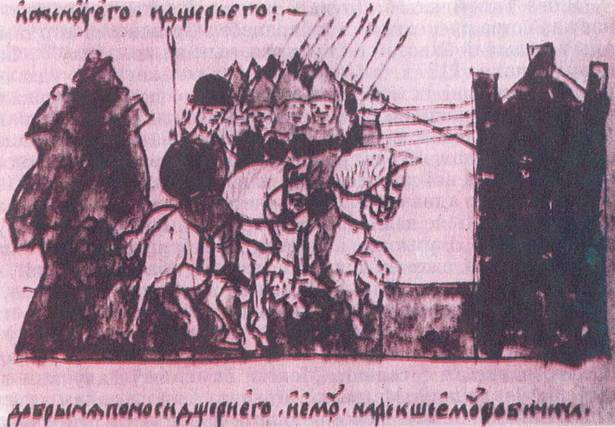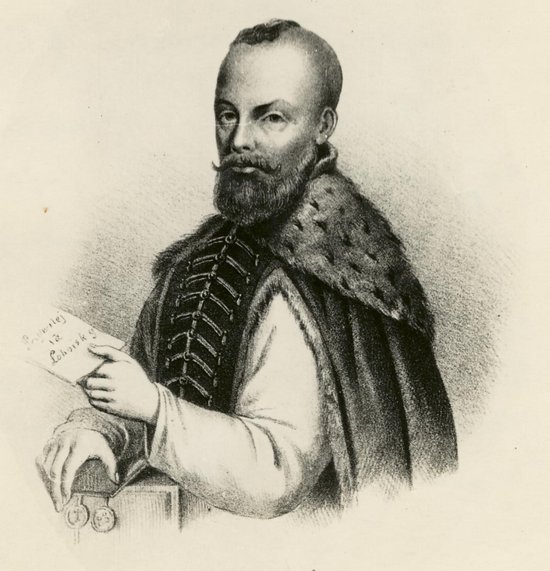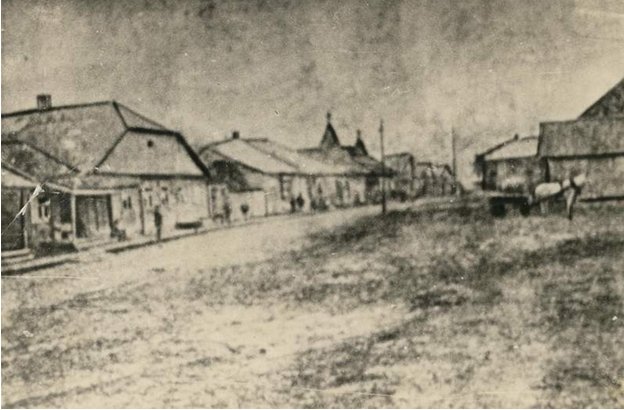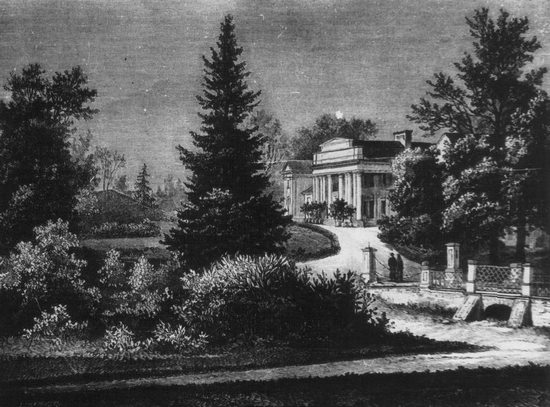Logoysk
Why shouldn’t the people, who lived more than a thousand years ago, have chosen this picturesque place on the right bank of the river Gaina to build a settlement? There was a rampart, topped with a citadel and a log wall, just where the Park of the former Tyszkiewicz family manor is situated. Surroundings could be seen for dozens of miles from high hills. It helped Logoysk (Logozhask) to serve as a fortification from invaders, coming from the south, on their way to Polotsk.
The original name of the city is “Logozhsk”.
According to the most reasonable opinion that name derives from the name of the river Logoza flowing into the river Hayna and it is formed by adding the suffix “-sk”. And in its turn the name “Logoza” is derived from the word “log”. It means “lowlands, valley” in Belarusian.
The first historical record of this town took place when the ancient Logoysk was a part of the Principality of Polotsk. Prince of Kiev Vladimir Monomakh wrote in 1078 in his famous Instruction (also known as The Testament):
Burnt earth and conquered lands to Lukoml and Logozhsk.
The next mention of the name “Logozhsk” took place in 1127 when Monomakh’s grandson organized a great campaign to Polotsk. The squad, consisting of the people from Logozhsk, was captured, and the “frightehed” town surrendered after a two-day siege.

Logozhsk became the center of the Principality and one of the parts of the Principality of Minsk. Vseslav Mikulich became the prince of the Principality of Logozhsk in 1180, and Vasil Valadarovich, the son of the Prince of Minsk — in 1186.
The last mention of the town in the XII century was connected with the change of the prince in 1186. Since then, there have never been any records of Logoysk for a long time. Judging by archaeological excavations held in 1966–1969 the town grew quickly in the XIII century but it was greatly damaged by fire. The cultural layer of the end of the XIII–XIV centuries has been seen slightly. It was the decline of the city. There is no mention of this city in the annals so only the legends and traditions can help us imagine that period. For example, according to one of the legends Logoysk region was described as the hilly area where churches stood less than a mile from each other. And the distance from the nearest church to farthest towards the ancient settlement could be more than a hundred miles!
The next turning point in Logoysk history was its becoming a part of the Grand Duchy of Lithuania in the first quarter of the XIV century. It was the beginning of a chain of changes in its belonging state. In the late XIV century Logoysk was the center of the small rural district, named volost, in the Grand Duchy of Lithuania and the territory was ruled by Lithuanian boyar Voyshvil. Orthodox Monastery of John the Baptist in Logoysk was mentioned in 1387. In the same year Skirgaylo received central lands of present-day Belarus from his older brother, Prince Jagiello Algerdovich. Logoysk was among those lands. Five years later, in 1392 Logoysk was under the Grand Duke’s Vytautas rule. Settlements near Logoysk, such as Gaina, Koren, Gostilovichi, Ostroshitsy and others, were first recorded in the early XV century. In 1460 the city was presented to Prince Alexander Chartoriysky (Czartoryski) by Grand Duke of the Grand Duchy of Lithuania and King of Poland Casimir.
The castle and the town got into a terrible plight in 1505: Crimean Tatars of Mahmet Giray looted and burned Logoysk and captured grandchildren of Alexander Chartoriysky. The final moment could be the last mention of the town in the annals of history; the long-suffering city of Logoysk was found to be on the way of destructive forces of the Grand Duchy of Moscow.
In 1514 Basil Tyshkevich (Tyszkiewicz) married to the granddaughter of Alexander Chartoriysky. Mr Basil Tyshkevich got both parts of Logoysk from sisters of Prince Semyon Chartoriysky (son of Alexander Chartoriysky) in 1528 and then in 1531; and became the first owner of the city of the genus Tyshkevich. In 1531–1532 Basil built a new castle, altered fortifications and Bogoyavlenskaya Church. In 1569, Basil Tyshkevich received the title of Count “on Logoysk and Berdychev” from Grand Duke of Lithuania and King of Poland Sigizmund II Augustus.

After the death of the first owner Tyszkiewicz his grandchildren Martin Yurevich and Fedor Yurevich came to power and shared the inheritance in half. However, this redistribution of Logoysk estate wasn’t also the last. Another Yurievich — Alexander Tyszkiewicz got the castle and the town Logoysk in 1603. He accepted Catholicism in Italy, and in 1604 he built a Catholic Church in Logoysk, where later the members of the genus Tyszkiewicz from Logoysk were buried. Joseph and Philon Tyszkiewiczs, sons of Martin, became the next generation of owners. Under their rule the surname “Tyszkiewicz” (Tyshkevich) found the final form of writing. And the descendants of Joseph and Philon owned town until 1927.
The war between Russia and the Polish-Lithuanian Commonwealth was also a hard time in Logoysk history. In 1655 the city was destroyed by Russian troops after five years of occupation. After that Logoysk could hardly be called the city; and the remaining households could be counted on the fingers of one hand. To revive the city, in 1673, citizens got the right to hold weekly auctions and two fairs a year.

The XVIII century was also destructive to Logoysk. In May 1708 during The Great Northern War (1700–1721) Swedish troops of Charles XII captured Logoysk, burned the castle, which was never rebuilt again after the war. Stanislav Tyszkiewicz built Baziliansky Monastery on the place, where some years earlier there had been a castle; a small music school and a parish school were opened there. In 1834 the monastery was closed, and in 1841 the building was dismantled.
In 1793, Russia and Prussia signed the convention on The Second Partition of the Polish-Lithuanian Commonwealth; according to this document Russia got the territory of present Logoysk district. At that time Logoysk was owned by Samogitian castellan Stanialav (the controller of the castle and surrounding areas) and Vincent Tyszkiewicz, a former Chancellor of the Grand Duchy of Lithuania. The next owner of the city Dominiс Feletsianovich Tyszkiewicz passed the right of possession to his younger brother — Pius Feletsianovich. He gave perhaps the most serious impetus to the all-round development of Logoysk.
Pius Tyszkiewicz was Marshal gentry of Borisov district, an honorary member of the Vilnius Archaeological Commission, the father of the famous Belarusian archeologists and ethnographers Constantine and Eustace. Count Pius rightly lived 102 years: from 1756 till 1858. Thanks to his efforts in 1815 a huge new Empire-style palace was built. The ruins of this castle stand in the Park of the former Tyszkiewicz family manor in Logoysk even today.

The second half of the XIX century was remarkable for Logoysk for opening a weaving mill, an agricultural plant, copper, leather, linen factories, a bank, a water mill, shops and many others. In 1918 Logoysk was occupied by German troops, in 1920 by Polish troops. The arrival of Soviet power in Logoysk district was greeted with peasant vandalism. The Tyszkiewiczs, who raised the city to the European level, were forced to leave the city.
In 1924, Logoysk became the center of Logoysk district, and in 1938 Logoysk acquired the status of urban settlement. In 1941–1944 years Logoysk was occupied by the Germans.
In 1943, there was Khatyn tragedy, and on the 19th of June in 1944 the village Dalva was burned.
